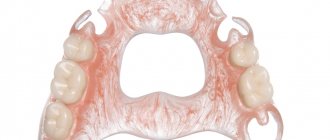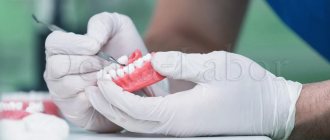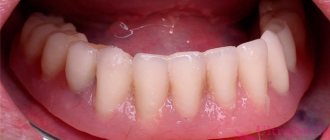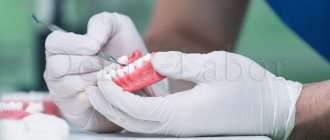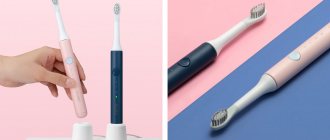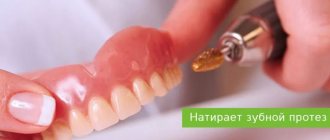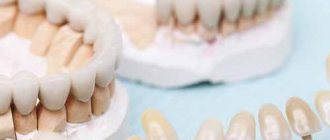The popularity of dentures with a fine structure among patients is determined by their aesthetic and functional characteristics. However, such structures do not always have a sufficient margin of strength and resistance to mechanical loads that occur during meals. The formation of even small, at first glance, damage often becomes the cause of discomfort, imbalance and configuration of the replacement system. To strengthen prostheses, internal reinforcement technology is used, which involves integrating a strong mesh into the frame of the product.
Types of denture reinforcement
The type of reinforcement depends on the type of alloys used:
- In general dental practice, metal mesh is used to reinforce plastic dentures.
- The strength of acrylic bases is increased by using metal spacers, aramid threads, and fiberglass.
- The most popular reinforcing component is a mesh made of noble metals, which prevent the development of allergies and have good compatibility with other materials.
Dentists most often use meshes made of wire, perforated or cast plates:
- aramid threads,
- cellulose fiber,
- fiberglass,
- polyethylene,
- carbon mesh,
- quartz fibers,
- cast alloy gaskets,
- mesh made of gold and silver alloys.
General overview
Reinforcement of dental prostheses is recommended as a procedure that increases the reliability of structures with a thin polymer base. As a rule, defects occur not only due to strong pressure or sharp contact with hard objects (for example, if dropped on the floor or into a sink during hygiene care), but also as a result of natural wear and tear. A frame metal or fiberglass mesh increases the functional potential of prosthetic products, extending their service life and ensuring comfortable wearing.
General requirements for reinforcement of removable dentures
When choosing material for reinforcement, the following factors must be taken into account:
- Biocompatibility (no allergy to it).
- Resistance to mechanical, chemical and bacterial influences.
- Durability, long service life.
- In general, the finished prosthetic structure must meet these requirements.
- Ideal fit to the gums.
- Accurately convey occlusion.
- Have a sufficient base thickness (about 2 mm).
- Do not have weakened zones in the polymer material, which can arise when the polymerization regime is violated.
- Acrylic teeth must be properly cured.
Indications and contraindications
When deciding to reinforce the prosthesis, you do not have to worry about possible discomfort after making changes to the structure of the structure. All reinforcing elements are located inside the base, do not come into direct contact with mucous tissues, and do not have a negative effect on the condition of the oral cavity. The indications, the presence of which is the reason for reinforcing the prosthetic system, include:
- Narrowing of the oral cavity - in such situations, the service life of the prosthesis increases many times, and its likelihood of damage is minimized;
- Prevention of possible fracture of the base of a worn prosthesis;
- Specific design of the bed, requiring reinforcement of the structure;
- The need for fixation of units of the dentition, characterized by increased mobility;
- Restoration of shrinkage density, eliminating chafing of the mucous membrane.
Limitations to the procedure are determined individually, during an examination in a clinical setting, as well as based on an analysis of the patient’s medical history.
Manufacturing and general requirements
The installation of the reinforcing mesh is carried out by a qualified dental technician, which is due to the complexity of the procedure. The whole process is divided into the following stages:
- Examination of the condition of the oral cavity and calculation of the potential load on supporting units;
- Preparation of a reinforcing mesh based on a plaster model of the jaw apparatus;
- Adjustment and installation of position limiters of the reinforcing element;
- Preliminary application of a fixing polymer composition;
- Installation of the base in the cuvette on one side of the grid;
- Applying the final layer of polymer, followed by sanding and polishing.
Installation of the reinforcing mesh is carried out only in the base, since placement in the beam part of the prosthesis does not increase the strength of the structure. It is recommended to reinforce deep areas with a pronounced relief texture. The duration of the procedure is from 7 to 10 days.
Before deciding to install a reinforced prosthetic structure, it is imperative to determine the presence of a possible allergy to acrylic or metal materials that are planned to be used to create an orthopedic product. Identifying limitations is an important condition, since otherwise the production of the system may not bring the desired result, since the patient will not be able to use the prosthesis for its intended purpose.
Advantages and disadvantages
The positive aspects of using reinforced prostheses are obvious:
- Strength and durability;
- Comfort and reliability;
- Convenient hygienic care;
- Aesthetics and functionality.
Strengthened models allow you to increase the load on the dentition without fear or negative consequences, which is important for patients in the older age group.
Among the disadvantages characteristic of the technology, there is an increase in the mass of prostheses reinforced with metal meshes, as well as the need to go through an adaptation period.
Reviews
Reinforcement of dentures began to be used not so long ago in orthopedic dentistry, but many patients have already formed their own opinion about reinforced structures.
It is important for our readers to know your feedback on the quality, wearing comfort and difficulty of caring for the products!
If you find an error, please select a piece of text and press Ctrl+Enter.
Tags denture reinforcement dentures
Did you like the article? stay tuned
Previous article
Augmentation - what is it and what is its significance in dentistry
Next article
What is a sinus lift during dental implantation?
Causes of structural fractures
During food consumption, products are subject to deformation loads, which leads to the appearance of a zone of high pressure or stress on the base. It is this area that most often provokes the formation of cracks and fractures.
Also, do not forget about the aging factor of the material, which is especially reflected in plastic. A fracture at the base may appear due to the nature of the material, or due to a violation of the laboratory and clinical stages of production.
The properties of the material may be different, so the causes of fractures may be:
- low strength;
- deep bend;
- swipe;
- stretching the base;
- aging of plastic bases;
- decrease in strength during polymerization when water is absorbed.
The accuracy of clinical and laboratory processes also plays an important role. Integrity is affected by:
- entry of a foreign body into the manufacturing process;
- poor quality wax removal;
- creating uneven base thickness;
- incorrect placement of reinforcing elements;
- erroneous determination of the central relationship of the jaws;
- violation of the polymerization regime.
If the product is deformed or cracked, you should immediately seek help from a specialist. It is not recommended to fix the problem yourself.
The essence of the procedure
What is dental reinforcement? The term “reinforcement” translated from Latin means “to strengthen”, “to arm”. Doctors at dental clinics perform the procedure when it is necessary to strengthen the root and crown of a destroyed unit or even completely restore a missing tooth.
Manipulation is also performed when it is necessary to strengthen a material (composite, acrylic) or structure (artificial crown, removable denture, bridge). This is done to ensure that the resulting restoration lasts as long as possible, has high wear resistance and correctly distributes the chewing load.
Service life
The service life is affected by the care of the prosthesis, but the quality of the structure itself also plays an important role.
On average, a simple orthopedic plastic prosthesis lasts an average of 2-3 years. At the end of the term, there is a need for relining or making a new prosthesis.
The service life of reinforced products can be 4 years or more. Of course, the quality of care, the degree of workload, and the individual characteristics of patients play a big role.
Why is splinting of mobile teeth necessary?
With moderate and severe periodontitis, tooth mobility becomes one of the main symptoms of the disease. As a rule, tooth mobility begins when bone tissue atrophies more than 1/4 of the length of the tooth root. Those. There is a direct connection between the amount of bone atrophy and the degree of tooth mobility.
Exposure of the necks of the front teeth is one of the visual signs of bone tissue atrophy (Fig. 1). In this case, we can see bone loss on an x-ray. Normally, the bone tissue should reach almost to the neck of the tooth. Compare the radiograph (Fig. 2), where there is bone atrophy at 1/2 the length of the root, with the radiograph (Fig. 3), where atrophy is completely absent.
At the moment when tooth mobility occurs during periodontitis, the rate of destruction (atrophy) of bone tissue accelerates many times over. In turn, the destruction of bone tissue around the tooth leads to even greater tooth mobility. In fact (in the absence of treatment), the process becomes uncontrollable with constant progression of inflammatory symptoms, including tooth mobility.
Over time, under the influence of chewing load, the moving teeth begin to gradually change their position, tilt in different directions, and also fan out (Fig. 4-6). To prevent all this, teeth splinting is necessary.
Price
The cost may vary significantly, since the price is affected not only by the type of reinforcing material. If there is a need to repair the structure, the cost of repair work may be affected by:
- complexity of deformation;
- urgency of repairs;
- use of additional elements or materials.
Each type of product has its own price, so it is important to clarify the cost of the procedure in advance. Average prices for reinforced prostheses:
- plastic - from 15,000 rubles;
- nylon – 37,000 rubles;
- partial acrylic – 25,000 rubles;
- full acrylic - from 30,000 rubles.
If the patient wants to get a foreign-made prosthesis, then its cost may increase by another 5,000-7,000 rubles.
